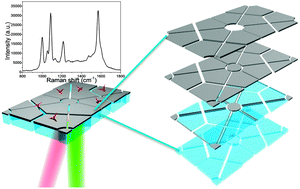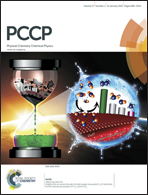Surface-enhanced Raman scattering on a hierarchical structural Ag nano-crown array in different detection ways†
Abstract
A highly ordered Ag nano-crown array with a hierarchical pattern is designed as a three-dimensional (3D) surface-enhanced Raman scattering (SERS) substrate. It was achieved by depositing Ag on a patterned polymethyl methacrylate (PMMA) film which precisely replicates the patterns of a honeycomb-like anodic aluminum oxide (AAO) template. We made a detailed analysis on the structure of Ag nano-crowns and place emphasis on the detection mode to optimize the excitation and collection of the SERS signals. Finite-different time-domain (FDTD) simulation was performed to confirm and compare electric field enhancement in the gaps between nano-crowns in two different detection ways. All the results exposed and confirmed that the unique detection way of the Ag nano-crown substrate which is different from the traditional mode is optimal. This hierarchical structural Ag nano-crown not only has satisfactory repeatability, but also provides high sensitivity which was supported by the high electric field enhancement in the proper detection way. As a practical application, the detection of pesticide thiram was achieved with a limit of detection down to 1.0 × 10−14 M. This hierarchical structural Ag nano-crown array on a polymer film is a promising candidate as a portable SERS chip.


 Please wait while we load your content...
Please wait while we load your content...